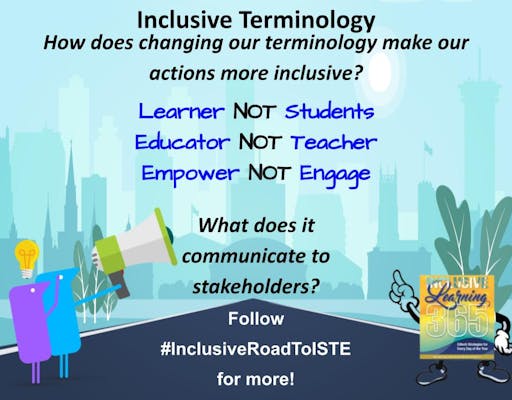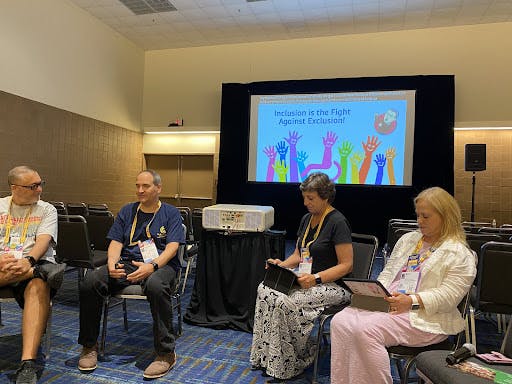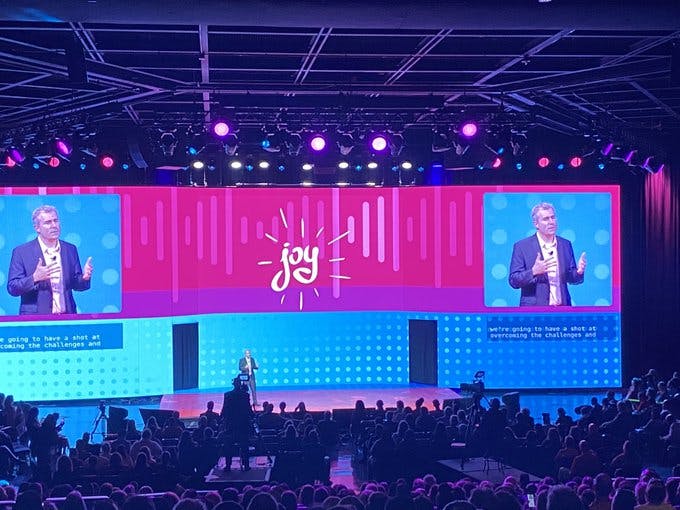ISTE Live 2022: 4 Steps to Build an Inclusive Learning Environment
What does an inclusive learning environment look like? That was one of the main questions I went to ISTE Live 2022 to answer. And I was not disappointed.
As you reflect, regroup, and refuel for the next school year, here are four steps you can take to build an inclusive learning environment.
Step 1: Incorporate inclusive language into your vocabulary
We had the honor of partnering with the authors of ‘Inclusive Learning 365: Edtech Strategies for Every Day of the Year’ on an Inclusive Road Trip to ISTE. Karen Janowski, Mike Marotta, Beth Poss and Chris Bugaj drove from Boston to New Orleans, sharing inclusive learning strategies, EdTech tips, and a whole lot of fun along the way.
While I’d encourage everyone to take a look at the #InclusiveRoadToISTE hashtag to explore all of the valuable content and resources they shared during their trip, there was one piece of advice that I’d like to share here: the importance of inclusive terminology.

When you start thinking about the words you use, you can see how they create a more inclusive environment. For example, by using “learner” and “educator”, there’s less of an “us vs. them” mindset. Now, anyone in the learning environment can be both a learner and an educator.
Step 2: Build a culture of inclusion
Tinashe Blanchet and Cori Brooks hosted a poster session, ‘Bring Equity to your K-12 STEM Classroom with Equatio Mathspace.’ During the session, Tinashe shared a video of an inclusive math lesson and asked participants to share what made it inclusive.
There were a couple of key points that stood out to the attendees. The first was that the one learner that was struggling with the concept was not afraid to admit she didn’t understand. And the second was that her peers did not bully her for not understanding. Instead, they became educators and worked to explain their thinking until their peer understood.
As Tinashe discussed, this culture of respect for all learners is something that the educator purposefully built. She recognized the importance of creating a safe space for learners to make mistakes and grow. To hear the full discussion, click the link to the recording below.
In the above clip, Tinashe references Jo Boaler, a British education author and Nomellini-Olivier Professor of Mathematics Education at the Stanford Graduate School of Education. For Jo, mistakes are a critical part of the learning process: “The recent neurological research on the brain and mistakes is hugely important for math teachers and parents, as it tells us that making a mistake is a very good thing. Mistakes are not only opportunities for learning, as students consider the mistakes, but also times when our brains grow.” Learn more about the benefits of mistakes.
Step 3: Normalize Multiple Means of Learning
In the recording above, you’ll also hear Tinashe talk about the value of encouraging learners to solve math problems in the way that makes most sense to them. While important for learning math, this is also a valuable inclusive practice for all subjects.
During their session on “Designing Instruction With an Inclusive Mindset”, the Inclusive 365 team talked about the importance of multiple means of instruction and learning. For them, it’s not only critical to have those options available for learners, but it’s also important to normalize those different ways of learning.

Oftentimes, learners won’t want to use assistive technology because they don’t want to feel like an outsider amongst their peers. But, as Universal Design for Learning (UDL) has taught us, what’s necessary for some can be valuable for all. While one learner may have an IEP that requires them to have access to text-to-speech, another learner may simply prefer text-to-speech because it helps them concentrate on what they are reading.
At Texthelp, our EdTech tools are built with UDL in mind. Take Equatio and ObritNote, two winners of the Tech & Learning Best of Show at ISTE 2022, as examples. Both tools provide a variety of features for learners to choose from to engage with learning and express their comprehension in the manner they prefer.
By offering resources like these to learners, you are normalizing different learning styles, which creates an inclusive learning environment for all, including those that may require additional supports.

Step 4: Let the learner lead
The last step I’d like to mention in creating an inclusive learning environment is to let the learner lead. Once we’ve created a learning environment that is inclusive, and provided the resources that support learning differences, the final step is to make sure that the learner has choice and voice in their learning.
By supporting learner agency, everyone benefits. Chris Bugaj, co-author of Inclusive Learning 365 and an AT specialist, said it best in this tweet:
“Educators who embrace learner agency find greater levels of freedom and joy. Those who put the learner first see those who they support gain skills and make connections, which keeps you coming back the next day/year.”

So, let’s start the next school year with some much needed joy, and these 4 steps to an inclusive learning environment.
